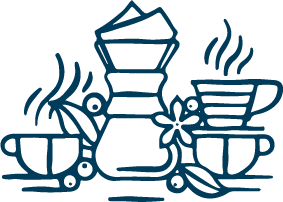PT's Brew Guides

Seven Things to Know Before You Brew
No matter what brewing method you choose, there are a few important basic rules to follow that will make a dramatic difference in the outcome of your brew. Read on to learn how to make great coffee every time:
Use Excellent Quality Coffee Beans
PT’s buys only the top 1% of coffee in the world, and we feel that an artisan coffee farmer who grows award-winning coffee should be given all of the credit. Recognition develops dedication to craftsmanship, skill in production, and passion for harvest quality.
Use Fresh-Roasted Coffee
Always start with fresh-roasted whole-bean coffee. Only use coffee that was roasted within two weeks of the brew time. Coffee begins to lose its flavor after about 12 days of storage, and this process is accelerated when the coffee is ground. Store your coffee in a cool, dry place in an airtight container—not in the refrigerator. When possible, buy only one week’s supply of beans at a time and grind just prior to brewing.
Use a Proper Grind
A proper grind is extremely important to the extraction of the brew. As a general rule, the longer the brew cycle, the coarser the grind. Espresso uses a very fine grind because of its quick 20-30 second extraction, whereas a French press requires a coarse grind, since the coffee is immersed in water for about four minutes. If possible, invest in a burr grinder, which will deliver an even and consistent grind every time. Blade grinders use a rotating blade to chop the coffee, which results in uneven grinds and inconsistent results from one cup to another. Consistency is extremely important for a quality cup.
Grind Coffee Just Before You Brew
Once coffee is ground, it will stale very quickly. Grinding coffee at night before you go to bed will expose the coffee to air for a prolonged period of time and cause a flat-tasting cup in the morning. Freshness is key to a quality cup!
Proper Dosing
Use approximately 6.5 grams of coffee (about one rounded tablespoon) for every 4 ounces of water. After you have made a few pots of coffee, adjust the dose to taste. Using too little coffee will lead to an over-extracted and bitter cup. The proper dose will result in an ideal extraction and a sweet cup of coffee, free of bitterness.
Clean Equipment is Essential
Before brewing, it is essential to make sure that your equipment is clean and free of both old grounds and stale coffee oils from previous brews. For the best results, always clean your equipment with water and a little bit of elbow grease immediately following the brew cycle. It only takes a few minutes, but in the long run, you will be able to taste the difference. Avoid using store-bought detergents on certain equipment. Store-bought soap will leave a film residue and foul the flavor of your coffee.
Use Pure Water
Coffee is 98% water, so using water from the tap may cause your great coffee to take on a tainted flavor. To get the best results out of your beans, use fresh, pure (not distilled) water.
